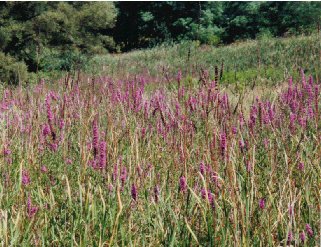
Some of the many species of plant introduced as crops, for industrial use, for their beauty in our gardens, and by accident are giving us trouble in our natural areas. Exotic plants can be divided into three groups: those that will not survive in our climate; those that will grow but the problems they give us are insignificant and a small but important number of plants that grow readily and can out compete our native plants and are changing our natural areas. Currently up to 40% of the wild plants in southern Ontario are exotic species. While most are relatively harmless, some are aggressive invaders spreading rapidly and monopolizing large areas. They will reduce the diversity of our fauna and flora and impoverish our ecosystems.
These invaders tend to thrive in disturbed areas, so urban natural areas and rapidly developing suburbs are prime locations for infestation. The best known of these is **purple loosestrife **(see picture below). Originally introduced as a garden ornamental, it escaped into the countryside and has spread to dominate the wetlands of eastern North America. It is a common sight in wet parts of the Don River watershed. Unfortunately it is not the only such plant. Several others are invading our woodlands and meadows and are just as dangerous. They include: garlic mustard, dog-strangling vine, common buckthorn, Norway maple, reed canary grass, common reed, Japanese knotweed, Canada thistle and tartarian honeysuckle. All prefer disturbed habitats and can spread rapidly and thus are a serious threat to the health of native ecosystems. Control measures are necessary to restore our natural areas.

Purple Loosestrife
The Association for Biodiversity Conservation (PO. Box 62, Station B, Toronto, Ontario, M5T 2T2) has developed the Invading Aliens program to educate the public and to counter this problem. The Task Force to Bring Back the Don is co-ordinating public involvement in removal of Japanese knotweed and the city and some private landowners are attempting to control Norway maple. With increased public awareness, removal of undesirable plants may become as important activity for communities as planting trees. (Information from article by Ken Towle in“On the Don” DWRC & TRCA)
There is more information is available at this site
